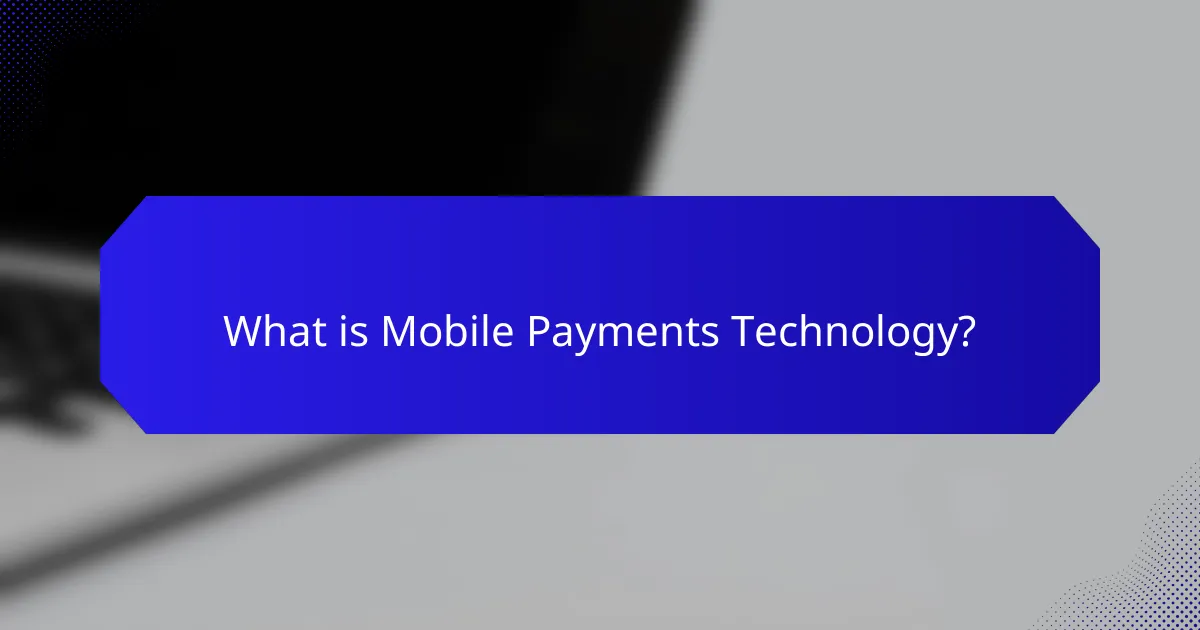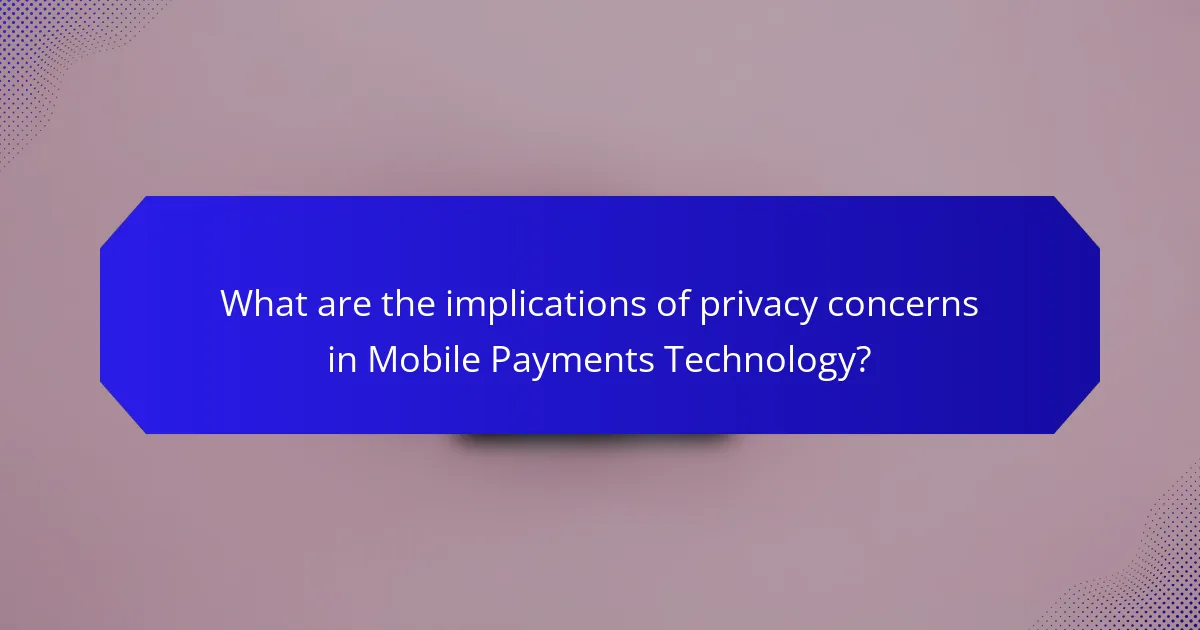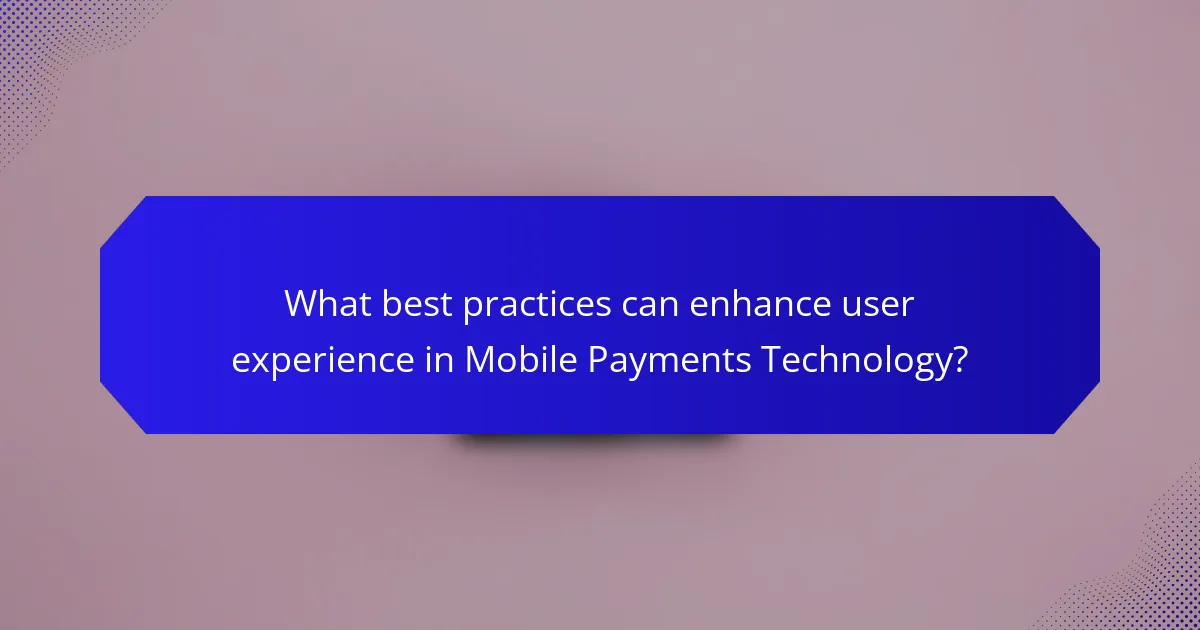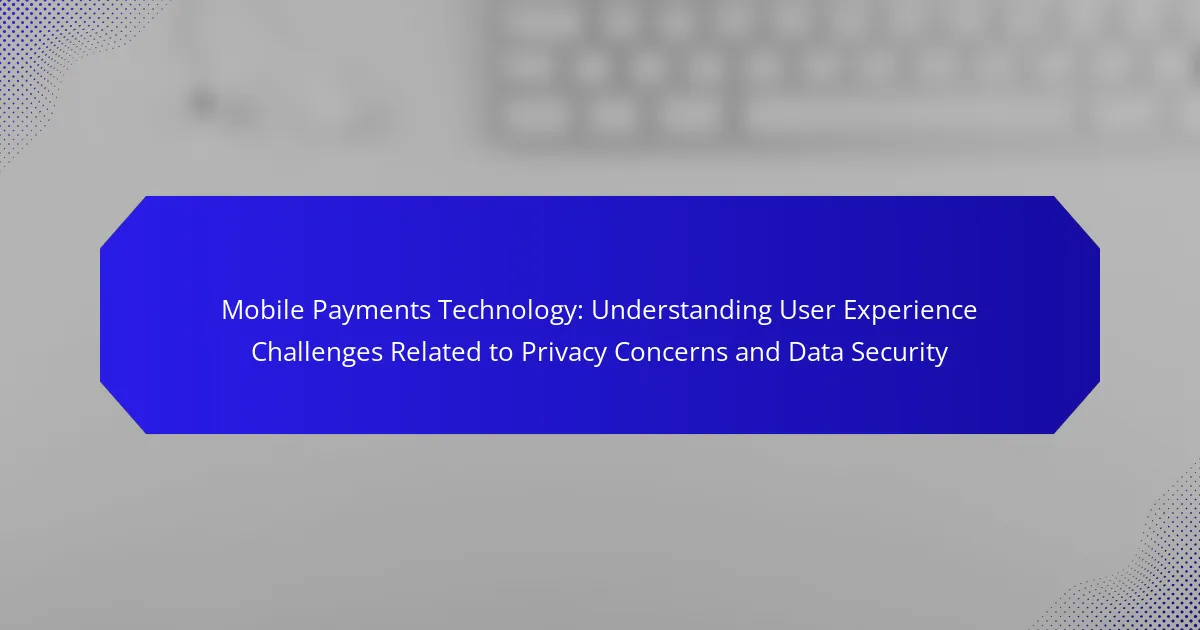Mobile payments technology enables financial transactions through mobile devices, such as smartphones and tablets, utilizing various methods like mobile wallets and contactless payments. The global mobile payment market is anticipated to exceed $12 trillion by 2025, driven by technological advancements and increased smartphone usage. However, privacy concerns pose significant challenges, as many users fear potential data breaches, which can lead to decreased trust and adoption of mobile payment solutions. To address these issues, enhancing user experience through best practices, such as simplifying interfaces, implementing biometric authentication, and providing robust customer support, is essential for fostering user confidence and promoting innovation in mobile payments.

What is Mobile Payments Technology?
Mobile payments technology refers to the use of mobile devices to facilitate financial transactions. This technology allows users to make payments using smartphones or tablets. It typically involves various methods, including mobile wallets, contactless payments, and in-app purchases. Mobile payments can enhance convenience for consumers by enabling quick transactions without cash or cards. According to Statista, the global mobile payment market is projected to reach over $12 trillion by 2025. The widespread adoption of mobile payments is driven by advancements in technology and increased smartphone [censured].
How does Mobile Payments Technology function in everyday transactions?
Mobile payments technology functions by enabling users to make transactions using their smartphones or other mobile devices. This process typically involves linking a payment method, such as a credit or debit card, to a mobile wallet application. When a user initiates a payment, the mobile wallet transmits payment information securely to the merchant’s point-of-sale system. This is often achieved through near-field communication (NFC) or QR code scanning.
The technology encrypts sensitive data to protect it during transmission. For example, Apple Pay and Google Pay use tokenization to replace card details with a unique identifier. This ensures that actual card numbers are not shared with merchants. Furthermore, mobile payments can require authentication methods, such as biometrics or PINs, to enhance security.
According to a report by Statista, mobile payment transaction value is projected to reach over $12 trillion by 2025, indicating rapid adoption and reliance on this technology for everyday transactions.
What are the key components of Mobile Payments Technology?
The key components of Mobile Payments Technology include mobile devices, payment applications, and secure payment gateways. Mobile devices serve as the primary platform for transactions. Payment applications facilitate the transaction process by enabling users to send and receive money. Secure payment gateways ensure that sensitive data is encrypted and transmitted safely. Additionally, Near Field Communication (NFC) technology allows for contactless payments. Tokenization is another critical component, replacing sensitive data with unique identifiers. Biometric authentication enhances security by verifying user identity through fingerprints or [censured] recognition. These components work together to create a seamless and secure mobile payment experience.
How do these components interact to facilitate transactions?
Mobile payments technology components interact through a network of systems that ensure secure and efficient transactions. These components include the mobile device, payment application, payment gateway, and financial institution. The mobile device initiates the transaction by sending payment information via the payment application. The payment application encrypts this data to protect user privacy and security. Next, the payment gateway processes the encrypted information and communicates with the financial institution. The financial institution verifies the transaction and authorizes the payment. This interaction occurs in real time, allowing for quick transaction completion. According to a study by the Federal Reserve, mobile payments have increased significantly, indicating the effectiveness of these components in facilitating transactions.
What are the primary user experience challenges in Mobile Payments Technology?
Primary user experience challenges in mobile payments technology include security concerns, usability issues, and trust deficits. Security concerns arise from the risk of data breaches and fraud. Usability issues often stem from complex interfaces that confuse users. Trust deficits can occur when users feel uncertain about the safety of their financial information. According to a 2021 survey by Statista, 43% of respondents cited security as their main concern regarding mobile payments. Additionally, a study from the Journal of Retailing found that 63% of consumers hesitate to use mobile payments due to usability barriers. These challenges hinder widespread adoption and user satisfaction in mobile payment systems.
Why are privacy concerns significant for users of Mobile Payments Technology?
Privacy concerns are significant for users of Mobile Payments Technology because they involve sensitive personal and financial information. Users risk unauthorized access to their data, which can lead to identity theft. A study by the Federal Trade Commission found that 1 in 4 consumers experienced identity theft. Mobile payment systems often collect location data, increasing the risk of misuse. Additionally, data breaches in mobile payment apps can expose user information to hackers. The lack of transparency in data handling practices further exacerbates these concerns. Users may feel vulnerable if they do not understand how their data is stored and shared. Overall, privacy concerns can undermine user trust in mobile payment systems.
How do data security issues impact user trust in Mobile Payments Technology?
Data security issues significantly reduce user trust in Mobile Payments Technology. When users perceive a risk of data breaches, they hesitate to engage with mobile payment platforms. A survey by PwC found that 79% of consumers expressed concern about data security in digital transactions. Additionally, high-profile data breaches, like the Target breach in 2013, led to a decline in consumer confidence in mobile payment systems. Users are less likely to adopt new payment technologies if they fear their personal information may be compromised. Therefore, addressing data security is crucial for enhancing user trust in mobile payments.

What are the implications of privacy concerns in Mobile Payments Technology?
Privacy concerns in mobile payments technology can lead to decreased user trust and adoption. Users fear that their personal and financial information may be compromised. Data breaches can result in significant financial losses for individuals and businesses. According to a 2021 study by J.D. Power, 40% of consumers are hesitant to use mobile payment apps due to privacy fears. Additionally, regulatory scrutiny may increase as governments seek to protect consumer data. This can lead to stricter compliance requirements for mobile payment providers. Ultimately, privacy concerns can hinder innovation in mobile payment solutions.
How do privacy concerns affect user adoption of Mobile Payments Technology?
Privacy concerns significantly hinder user adoption of mobile payments technology. Users often worry about data breaches and unauthorized access to personal information. A survey by the Pew Research Center found that 81% of Americans feel they have little control over their personal data. This lack of trust leads to hesitance in utilizing mobile payment systems. Users are particularly concerned about how their data is stored and shared by payment providers. Additionally, incidents of high-profile data breaches amplify these fears. As a result, potential users may opt for traditional payment methods over mobile solutions. This trend indicates that addressing privacy issues is crucial for increasing adoption rates.
What measures can be taken to enhance user privacy in Mobile Payments?
To enhance user privacy in mobile payments, implementing strong encryption methods is essential. Encryption protects sensitive data during transactions. Utilizing tokenization can also safeguard user information. Tokenization replaces sensitive data with unique identifiers. Regularly updating security protocols is critical to protect against vulnerabilities. Biometric authentication adds an extra layer of security through unique user traits. Educating users about privacy settings can empower them to make informed choices. Lastly, compliance with privacy regulations, such as GDPR, ensures adherence to best practices. These measures collectively contribute to a more secure mobile payment environment.
How do different demographics perceive privacy risks in Mobile Payments?
Different demographics perceive privacy risks in mobile payments variably. Younger users often prioritize convenience over privacy. They may underestimate risks due to familiarity with technology. In contrast, older users typically exhibit higher privacy concerns. They are more cautious about sharing personal information. Gender differences also exist; women often express greater apprehension regarding data security. Research indicates that income levels influence perceptions as well. Higher-income individuals may trust mobile payment systems more than lower-income users. A study by Pew Research Center found that 60% of adults aged 18-29 feel secure using mobile payments, compared to 30% of those aged 65 and older. These insights highlight the diverse perspectives on privacy risks across different demographic groups.
What role does data security play in user experience with Mobile Payments Technology?
Data security is crucial for enhancing user experience in mobile payments technology. It builds trust between users and service providers. Users are more likely to engage with mobile payment systems that safeguard their financial information. A 2021 survey by Statista indicated that 42% of users cited security concerns as a reason for not using mobile payments. Effective data security measures, such as encryption and two-factor authentication, significantly reduce the risk of fraud. This assurance leads to increased usage and customer satisfaction. Consequently, robust data security directly influences the overall perception and acceptance of mobile payment platforms.
What are common data security threats faced by Mobile Payments users?
Common data security threats faced by mobile payments users include phishing attacks, malware, and data breaches. Phishing attacks target users through deceptive emails or messages to steal personal information. Malware can infect mobile devices, capturing sensitive data like passwords and payment details. Data breaches occur when unauthorized access to payment systems exposes user data. According to a report by the Federal Trade Commission, mobile payment fraud has been on the rise, highlighting the need for heightened security measures. Additionally, insecure Wi-Fi networks can expose transactions to eavesdropping, increasing vulnerability. Users must remain vigilant against these threats to protect their financial information.
How can Mobile Payments platforms improve their data security protocols?
Mobile payments platforms can improve their data security protocols by implementing advanced encryption methods. Strong encryption protects sensitive user data during transactions. Multi-factor authentication adds an extra layer of security, making unauthorized access more difficult. Regular security audits help identify vulnerabilities in the system. Compliance with industry standards, such as PCI DSS, ensures adherence to best practices. Utilizing tokenization replaces sensitive data with non-sensitive equivalents, reducing exposure risk. Continuous monitoring of transactions can detect and prevent fraudulent activities in real-time. Training employees on security protocols enhances overall awareness and response to potential threats.

What best practices can enhance user experience in Mobile Payments Technology?
User experience in mobile payments technology can be enhanced through several best practices. Simplifying the user interface improves navigation and transaction ease. Clear labeling of buttons and options helps users understand their actions. Implementing biometric authentication increases security and convenience. Providing multiple payment options caters to user preferences. Ensuring fast transaction processing reduces wait times and frustration. Offering real-time transaction notifications keeps users informed about their activities. Regularly updating the app enhances security and user trust. Lastly, incorporating customer support options within the app assists users in resolving issues promptly.
How can users protect their privacy when using Mobile Payments?
Users can protect their privacy when using mobile payments by enabling security features on their devices. This includes using biometric authentication like fingerprints or [censured] recognition. Users should also ensure that their mobile payment apps are updated regularly to patch security vulnerabilities.
Utilizing virtual private networks (VPNs) can add an extra layer of security when making transactions over public Wi-Fi. Users should avoid connecting to unsecured networks while conducting financial transactions.
Additionally, they should review app permissions to limit access to sensitive information. Using strong, unique passwords for mobile payment accounts can further enhance security.
According to a report by the Federal Trade Commission, consumers should monitor their bank statements regularly to detect unauthorized transactions quickly.
What tools and resources are available for users to enhance their data security?
Users can enhance their data security through various tools and resources. Password managers like LastPass and Dashlane help generate and store complex passwords securely. Two-factor authentication (2FA) apps, such as Google Authenticator, provide an extra layer of security. Virtual private networks (VPNs) like NordVPN encrypt internet connections, safeguarding user data from potential breaches. Antivirus software, such as Norton or McAfee, protects devices from malware and viruses. Security awareness training resources educate users on identifying phishing attempts and other threats. Regular software updates ensure that devices have the latest security patches. These tools and resources collectively enhance user data security by addressing various vulnerabilities.
How can users stay informed about privacy policies and data security measures?
Users can stay informed about privacy policies and data security measures by regularly checking the official websites of service providers. Many companies publish updates on their privacy policies in a dedicated section. Users should also subscribe to newsletters or alerts from these providers for timely information. Following relevant social media accounts can provide updates in real-time. Additionally, reading third-party reviews and articles can offer insights into data security practices. Participating in forums or communities focused on privacy can enhance understanding. Users should also familiarize themselves with regulatory changes that may affect their data rights. Engaging with educational resources from trusted organizations can further enhance awareness.
What are the future trends in Mobile Payments Technology regarding privacy and security?
Future trends in mobile payments technology focus on enhanced privacy and security measures. Biometric authentication, such as fingerprint and [censured] recognition, will become standard. This technology provides a secure way to verify user identity. Encryption methods will also evolve, making transactions more secure. Blockchain technology will play a significant role in ensuring data integrity. It offers a decentralized approach, reducing the risk of data breaches. Additionally, regulations like GDPR will shape how companies handle user data. These regulations emphasize user consent and data protection. The integration of artificial intelligence will help detect fraudulent activities in real-time. Overall, these trends aim to build user trust and enhance the security of mobile payment systems.
How might emerging technologies influence user experience in Mobile Payments?
Emerging technologies significantly enhance user experience in mobile payments. These technologies include biometrics, artificial intelligence, and blockchain. Biometric authentication, such as fingerprint or [censured] recognition, simplifies the payment process. It offers users a faster and more secure way to authorize transactions.
Artificial intelligence improves transaction speed and personalization. AI algorithms analyze user behavior to provide tailored recommendations. This personalization increases user satisfaction and engagement.
Blockchain technology enhances security and transparency in mobile payments. It reduces fraud risks and ensures data integrity. According to a report by PwC, 59% of financial services firms are investing in blockchain technology to improve transaction security.
These advancements lead to a seamless and trustworthy payment experience for users.
What proactive steps can Mobile Payments providers take to address user concerns?
Mobile Payments providers can enhance user trust by implementing robust security measures. They should utilize end-to-end encryption to protect transaction data. Regular security audits can identify vulnerabilities in their systems. Educating users about security features fosters confidence in the service. Providers can also offer two-factor authentication to add an extra layer of protection. Transparency in data handling practices builds user trust. Regularly updating users on security protocols can address ongoing concerns. According to a 2021 survey by Statista, 52% of users expressed concerns about data security in mobile payments, highlighting the need for these proactive measures.
Mobile payments technology refers to the use of mobile devices for financial transactions, encompassing methods such as mobile wallets, contactless payments, and in-app purchases. This article examines user experience challenges related to privacy concerns and data security within mobile payments, highlighting the significance of security measures and user trust. It addresses key components of mobile payment systems, security threats, and demographic perceptions of privacy risks, while also discussing best practices for enhancing user experience and protecting privacy. The article concludes with insights into future trends and proactive steps that providers can take to address user concerns effectively.
